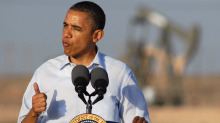Obama puts oil pipeline on fast track
 Deep in Republican oil country, President Barack Obama is fending off criticism of his energy policies, pointing to plans to fast-track an oil pipeline that emerged after he delayed the larger Keystone XL project earlier this year.
Deep in Republican oil country, President Barack Obama is fending off criticism of his energy policies, pointing to plans to fast-track an oil pipeline that emerged after he delayed the larger Keystone XL project earlier this year.Mr. Obama was directing federal agencies Thursday to expedite a 485-mile line from Oklahoma to refineries on Texas’ Gulf Coast that would remove a critical bottleneck in the country’s oil transportation system. The directive would also apply to other pipelines that alleviate choke points.
“We’re drilling all over the place,” Mr. Obama said in Maljamar, N.M., on Wednesday, standing alongside oil rigs on federal land. The president was announcing his plans for the expedited pipeline, a southern portion of the original Keystone XL, in Cushing, Okla., where construction is expected to begin this spring.
In oil fields and amid acres of solar panels, Mr. Obama is trying to rebut charges that he has stifled domestic energy production and been too eager to spend government money on renewable energy projects as gas prices have climbed to $3.86 a gallon. His emphasis on oil drilling is aimed at countering criticism of his rejection of the 1,700-mile Keystone XL pipeline, which would carry tar sands oil from western Canada to refineries along the Texas Gulf Coast.
For Mr. Obama’s advisers, rising gas prices pose a threat to his re-election bid because they could undermine the benefits of a payroll tax cut that he made the centrepiece of his jobs agenda last fall — Congress approved the tax cut extension in February — and throttle the economic recovery.
Republicans view rising gas prices as emblematic of Mr. Obama’s energy record and hope to tag him with the blame even though no president has much control over prices at the pump. Gas prices have risen more than 50 cents a gallon since January in response to a standoff over Iran’s nuclear program that has threatened to disrupt Middle East oil supplies.
GOP presidential hopeful Rick Santorum, campaigning at a Harvey, La., company that services oil rigs, said Mr. Obama’s administration should open more federal lands for leases to boost U.S. oil production and revenue for the federal government.
“Here’s an opportunity for us in this country to do something about it: increasing jobs, lowering energy prices, decreasing the deficit, all of the things you would think the president of the United States would be for,” Mr. Santorum said.
Mitt Romney, Mr. Santorum’s chief rival for the Republican nomination, has labelled Mr. Obama’s top energy advisers as the “gas hike trio,” urging the president to fire three Cabinet secretaries because of the high prices.
The status of the Keystone XL pipeline has been a focal point in the heated political fight over energy development.
Calgary-based TransCanada said it hopes to complete the $2.3 billion Oklahoma-to-Texas section next year after receiving the last approvals it needs to start construction. Many of the permits and environmental reviews already have been completed as part of the larger Keystone project, company officials said.
Republicans questioned whether the executive actions by Obama would speed up the pipeline’s construction and said it reiterated the need for the larger Keystone XL pipeline.
“The American people can’t afford more half-measures on energy from the president. No matter what he says, the reality is he killed the Keystone pipeline and the energy production and 20,000 jobs that went with it,” said Kirsten Kukowski, a Republican National Committee spokeswoman.
Mr. Obama’s energy tour was also aimed at defending his administration’s support of renewable energy projects, an agenda tarnished by his administration’s decision to pump millions into California solar company Solyndra before it collapsed.
In an interview with American Public Media’s “Marketplace” on Wednesday, Mr. Obama noted that the funding came from a loan guarantee program approved by Congress to help renewable energy companies, some of which would not succeed.
“Do I wish that Solyndra had gone bankrupt? Absolutely not. And obviously it’s heartbreaking what happened to the workers who were there,” Mr. Obama said. “When you look at the overall portfolio, is it right for us to make sure that we’re not just cashing in our chips and letting the Chinese or the Germans develop the technologies that we know are going to be critical in the future? I’m proud to say that we’re going to continue to support it.”
Electoral politics remain close to the surface. Nevada and New Mexico remain top targets on Mr. Obama’s 2012 election map, and while Republican stronghold Oklahoma will get scant attention from his political team, taking his message to the site of a future oil pipeline allows him to strike back at his chief critics on energy.
Mr. Obama was ending the day with a stop in battleground Ohio, talking about automobile research and development at Ohio State University in Columbus. The president has cited his decision to raise fuel efficiency standards to 55 miles per gallon for new vehicles by 2025 as an important step in conserving oil and saving consumers at the gas pump.
Mr. Obama has repeatedly invoked his decision to rescue General Motors and Chrysler from collapse with billions in federal aid, a move that saved hundreds of thousands of auto assembly and supplier jobs in Ohio, Michigan and elsewhere. Romney opposed the bailout, and Mr. Obama’s team intends to make it a stark contrast between the two candidates if the former Massachusetts governor wins the GOP nomination.
You can return to the main Market News page, or press the Back button on your browser.

